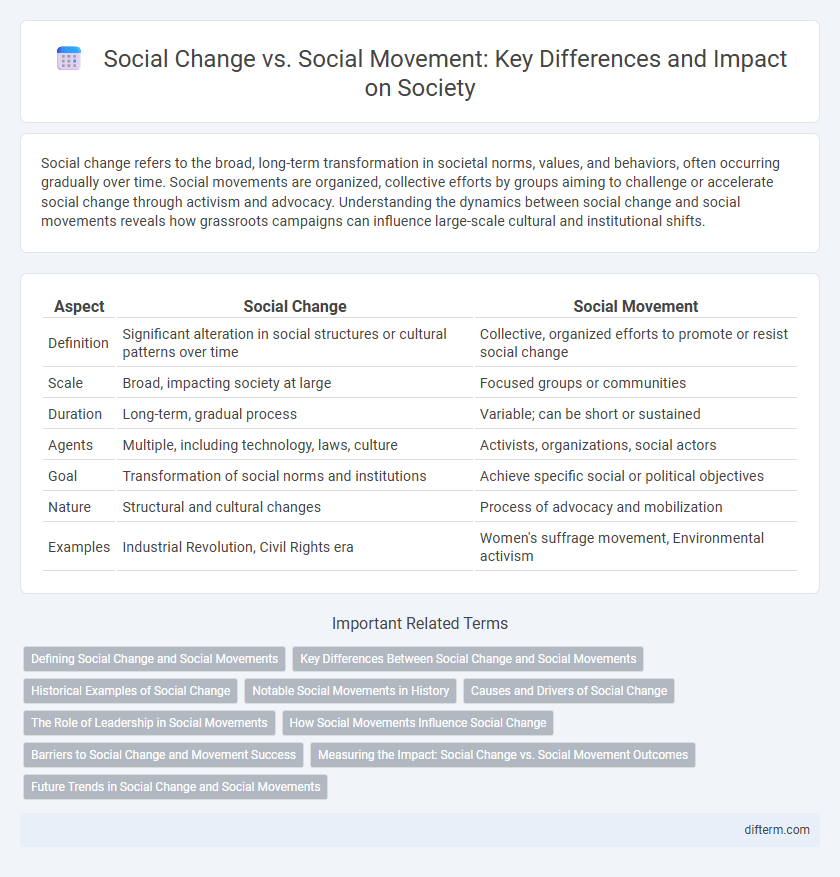Social change refers to the broad, long-term transformation in societal norms, values, and behaviors, often occurring gradually over time. Social movements are organized, collective efforts by groups aiming to challenge or accelerate social change through activism and advocacy. Understanding the dynamics between social change and social movements reveals how grassroots campaigns can influence large-scale cultural and institutional shifts.
Table of Comparison
| Aspect | Social Change | Social Movement |
|---|---|---|
| Definition | Significant alteration in social structures or cultural patterns over time | Collective, organized efforts to promote or resist social change |
| Scale | Broad, impacting society at large | Focused groups or communities |
| Duration | Long-term, gradual process | Variable; can be short or sustained |
| Agents | Multiple, including technology, laws, culture | Activists, organizations, social actors |
| Goal | Transformation of social norms and institutions | Achieve specific social or political objectives |
| Nature | Structural and cultural changes | Process of advocacy and mobilization |
| Examples | Industrial Revolution, Civil Rights era | Women's suffrage movement, Environmental activism |
Defining Social Change and Social Movements
Social change refers to significant transformations in cultural, economic, political, or social institutions over time, reshaping societal structures and norms. Social movements are organized, collective efforts by groups aiming to promote or resist social change through sustained activism. Understanding the distinction between social change as a broader phenomenon and social movements as the agents driving these changes is crucial for analyzing societal evolution.
Key Differences Between Social Change and Social Movements
Social change refers to broad, long-term transformations in societal structures, behaviors, and cultural norms, while social movements are organized efforts by groups aiming to drive or resist such changes. Social change often occurs gradually and can result from various factors including technological advances, economic shifts, or legal reforms, whereas social movements are deliberate, collective actions seeking specific social or political goals. The scope of social change is typically wider and more systemic, contrasting with the focused, strategic nature of social movements.
Historical Examples of Social Change
The abolition of slavery in the 19th century exemplifies social change driven by a prolonged social movement that combined activism, legislation, and public awareness. The Civil Rights Movement of the 1950s and 1960s led to transformative legal and cultural shifts in the United States, addressing racial segregation and discrimination. These historical examples demonstrate how sustained collective action can catalyze systemic social change over time.
Notable Social Movements in History
Notable social movements in history, such as the Civil Rights Movement, women's suffrage, and the environmental movement, have driven significant social change by challenging existing norms and promoting equality, justice, and sustainability. These movements utilize collective action, protests, and advocacy to influence public policy and societal attitudes. The distinction between social change and social movements lies in the former being the broader transformation in society, while the latter represents organized efforts that actively work to initiate and sustain these changes.
Causes and Drivers of Social Change
Social change occurs due to factors such as technological advances, economic shifts, cultural transformations, and political developments that alter societal structures over time. Social movements arise as organized collective efforts driven by grievances, identity, ideology, and shared goals to address inequities and demand reforms. While social change is often gradual and broad, social movements act as catalysts by mobilizing resources and raising awareness to accelerate transformation.
The Role of Leadership in Social Movements
Leadership in social movements plays a critical role in mobilizing resources, shaping collective identity, and sustaining momentum for social change. Effective leaders articulate clear goals, inspire participation, and navigate political opportunities to influence public policy and societal norms. Their strategic vision and organizational skills often determine the success or failure of social movements in achieving lasting social transformation.
How Social Movements Influence Social Change
Social movements play a crucial role in driving social change by mobilizing collective action and raising awareness about specific issues. These organized efforts challenge existing social norms and policies, leading to legislative reforms and shifts in public opinion. By creating platforms for marginalized groups, social movements foster greater inclusivity and equity within society.
Barriers to Social Change and Movement Success
Barriers to social change often include entrenched cultural norms, institutional resistance, and limited access to resources, which hinder the progress of social movements. Social movements face challenges such as political opposition, media bias, and internal fragmentation that can reduce their effectiveness and sustainability. Overcoming these barriers requires strategic organization, coalition-building, and adaptive tactics to mobilize support and influence public policy.
Measuring the Impact: Social Change vs. Social Movement Outcomes
Measuring the impact of social change involves assessing long-term transformations in societal values, institutions, and behaviors, often reflected in policy reforms, shifts in cultural norms, and improved social equity indicators. Social movement outcomes are typically evaluated through immediate achievements such as increased public awareness, mobilization of communities, and successful advocacy campaigns. Quantitative metrics like legislation passed and qualitative analyses of community empowerment provide a comprehensive understanding of both social change and social movement effectiveness.
Future Trends in Social Change and Social Movements
Emerging technologies like artificial intelligence and social media platforms are accelerating the pace and reach of social movements, enabling real-time mobilization and global activism. Future social change is expected to be driven by increased digital connectivity, intersectional advocacy, and decentralized leadership models emphasizing grassroots participation. Data analytics and predictive modeling will play crucial roles in identifying emerging social issues and shaping strategic responses for sustained impact.
social change vs social movement Infographic

 difterm.com
difterm.com